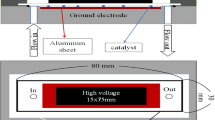Abstract
By using a self-designed non-thermal plasma (NTP) injection system, an experimental study of the regeneration of DPF was conducted at different temperatures, where oxygen as the gas source. The results revealed that PM can be decomposed to generate CO and CO2 by these active substances O3, O which was generated through the discharge reaction of NTP reactor. With the increasing of test temperature, the mass of C1 (C in CO) shows a overall downward trend while the mass of C2 (C in CO2) and C12 (C1 and C2) increase firstly and then decrease. When the test temperature is 80°C, the backpressure of DPF decreases fastest and the regenerative effect is remarkable. DPF can be regenerated by NTP technology without any catalyst at a lower temperature. Compared with the traditional regeneration method, the NTP technology has its superiority.
Similar content being viewed by others
References
Bensaid, S., Caroca, C. J., Russo, N. and Fino, D. (2011). Detailed investigation of non-catalytic DPF regeneration. The Canadion J. Chemical Engineering 89, 2, 401–407.
Cai, Y. X., Zhao, W. D., Wu, J. X., Wang, J., Li, X. H. and Liu, Z. N. (2005). Working principle experimental research on non-thermal plasma reactor. Trans. Chinese Society for Agricultural Machinery 36, 10, 117–120.
Chen, K., Martirosyan, K. S. and Luss, D. (2011). Temperation gradients with a soot layer during DPF regeneration. Chemical Engineering Science, 66, 2968–2973.
Cho, Y. S., Kim, D. S. and Park, Y. J. (2008). Pressure drop and heat transfer of catalyzed diesel particulate filters due to changes in soot loading and flow rate. Int. J. Automotive Technology 9, 4, 391–396.
Debora, F. and Vito, S. (2008) Open issues in oxidative catalysis for diesel particulate abatement. Powder Technology, 180, 64–73.
Fushimi, C., Madokoro, K., Yao, S., Fujioka, Y. and Yamada, K. (2008). Influence of polarity and rise time of pulse voltage waveforms on diesel particulate matter removal using an uneven dielectric barrier discharge reactor. Plasma Chem Plasma Process, 28, 511–522.
Ishizaki, K., Tanaka, S., Kishimoto, A., Tanaka, M., Ohya, N. and Hidaka, N. (2012). LProc. FISITA 2012 World Automotive Cong. ecture, Notes in Electrical Engineering, 189, 633–642.
Kogelschatz, U., Eliasson, B. and Hirth, M. (1988). Ozone generation in from oxygen and air discharge physics and reaction mechanisms. Ozone Science and Engineering 10, 4, 367–377.
Lee, S. J., Jeong, S. J., Kim, W. S. and Lee, C. B. (2008). Computational study on the effects of volume ratio of DOC/DPF and catalyst loading on the PM and NOx emission control for heavy-duty diesel engines. Int. J. Automotive Technology 9, 6, 659–670.
Lee, S., Cho, Y., Song, M., Kim, H., Park, J. and Baik, D. (2012). Experimental study on the characteristics of nano-particle emissions from a heavy-duty diesel engine using a urea-SCR system. Int. J. Automotive Technology 13, 3, 355–363.
Levendis, Y. A. and Larsen, C. A. (1999). Use of ozoneenriched air for diesel particulate trap regeneration. SAE Paper No. 1999-01-01.
Li, K. H., Cai, Y. X., Li, X. H., Hang, W. H., Weng, X. and Jiang, F. (2012). Experimental study on the performance of a water-cooled non-thermal plasma reactor. Trans. Chinese Society of Agricultural Engineering 28, 22, 69–75.
Martyn, V. T. (2007). Progress and future challenges in controlling automotive exhaust gas emissions. Applied Catalysis B: Environmental, 70, 1–4, 2–15.
Okubo, M., Arita, N., Kuroki, T., Yoshida, K. and Yamamoto, T. (2008). Innovative approach of PM removal system for a light-duty diesel vehicle using nonthermal plasma. Plasma Chem Plasma Process, 28, 173–187.
Okubo, M., Kuroki, T., Kawasaki, S., Yoshida, K. and Yamamoto, T. (2009). Continuous regeneration of ceramic particulate filter in stationary diesel engine by nonthermal-plasma-ozone injection. IEEE Trans. Industry Applications 45, 5, 1568–1574.
Raghu, B. and Rajasekhar, B. (2011). Emissions of particulate-bound elements from stationary diesel engine: Characterization and risk assessment. Atmospheric Environment 45, 30, 5273–5281.
Shim, B. J., Park, K. S., Koo, J. M., Nruyen, M. S. and Jin, S. H. (2013). Estimation of soot oxidation rate in DPF under carbon and non-carbon based particulate matter accumulated condition. Int. J. Automotive Technology 14, 2, 207–212.
Srinivasan, A. D. and Rajanikanth, B. S. (2007). Nonthermal-plasma-promoted catalysis for the removal of NOx from a stationary diesel-engine exhaust. IEEE Trans. Industry Applications 43, 6, 1507–1514.
Takaki, K. and Chang, J. S. (2004). Atmospheric pressure of nitrogen plasmas in a ferro-electric packed bed barrier discharge reactor. IEEE Trans. Dielectrics and Electrical Insulation 11, 3, 481–490.
Triana, A. P., Johnson, J. H. and Yang, S. L. (2003). An experimental and numerical study of the performance characteristics of the diesel oxidation catalyst in a continuously regenerating particulate filter. SAE Paper No. 2003-01-3176.
Walter, K. (2008). Diesel engine development in view of reduced emission standards. Energy, 33, 264–271.
Wang, T., Sun, B. M., Xiao, H. P., Wang, D., Zhu, X. Y. and Zhong, Y. F. (2013). Effect of water vapor on NO removal in a DBD reactor at different temperatures. Plasma Chem Plasma Process, 33, 681–690.
Yagi, S. and Tanaka, M. (1979). Mechanism of ozone generation in ar-fed ozonisers. J. Phys. D: Applied. Phys. 12, 9, 1509–1520.
Author information
Authors and Affiliations
Corresponding author
Rights and permissions
About this article
Cite this article
Shi, Y.X., Cai, Y.X., Li, X.H. et al. Meachanism and method of DPF regeneration by oxygen radical generated by NTP technology. Int.J Automot. Technol. 15, 871–876 (2014). https://doi.org/10.1007/s12239-014-0091-x
Received:
Revised:
Accepted:
Published:
Issue Date:
DOI: https://doi.org/10.1007/s12239-014-0091-x




